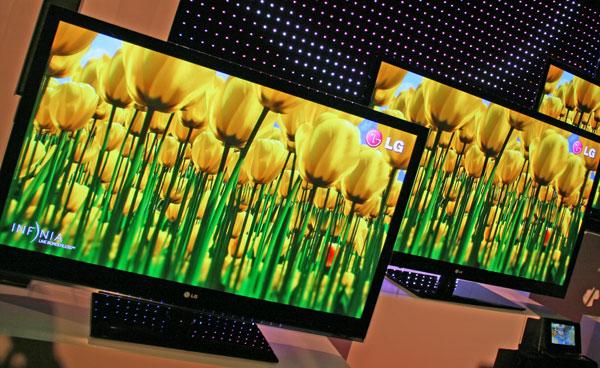Plasmas, Bi-Amping, Lossless Audio

What is your opinion about LG’s 50PK950 and 50PK750 plasma TVs? I understand the main difference is contrast ratio. Will I notice much of a difference between the two? Or should I stay away from plasma altogether?
Gary Johnson
We haven't reviewed either one, so I can't address their performance specifically. (However, we just posted a review of the 50PX950 here.) The PK950's dynamic contrast ratio is spec'd at 5,000,000:1, while the PK750's is listed as 3,000,000:1. I believe both of these numbers to be completely meaninglessthey are probably derived under unrealistic conditions, and I've found that dynamic contrast generally hurts the overall picture quality. What's really important is the black level and native (non-dynamic) contrast ratio, which few manufacturers reveal.
The LG plasmas we've reviewed, including the 50PX950, have had relatively high black levels, which is not good. Panasonic plasmas are generally much better in this regard.
I would not recommend staying away from plasma altogether. In fact, I prefer the look of plasma over LCD in general. If you have at least some control over the ambient light in your viewing room, plasma is the way to go in my book. On the other hand, if you mostly watch in a brightly lit room, an LED-illuminated LCD might be a better choice.
Bi-Amp Blues
I am getting a Pioneer SC25 A/V receiver soon, and I have a pair of Monitor Audio RS6 speakers, which can be bi-amped. Will this make a significant sonic difference? Would you recommend it?
Bob Yang
I'll let Tom Norton take this one:
In the pro-audio world, bi-amping implies a direct amp feed to each driver with electronic crossovers in front of the amps. But in the audiophile world, more often than not it means using the bi-wire/bi-amp input terminals of the speakers with a separate amp (or amp channel from the receiver) feeding each one. That means the speaker's passive crossovers remain in the circuit.
The situation is complicated by the fact that most consumer speakers use the crossover network for more than just dividing the audio into frequency bands suitable for the drivers. They often to correct for driver anomalies, flatten driver impedance, provide proper phasing between the drivers, etc. You can do these sorts of things in the pro configuration (no passive crossovers) with complex equalization and other processing in front of the amps in conjunction with electronic high- and lowpass filters, but that's beyond the reach of most audiophile hobbyists.
If you were to rip out the passive crossovers from your speakers and connect the drivers directly to the amps with an electronic crossover to direct the frequencies to the proper drivers but with no additional processing, the result would most likely sound terrible. Why? Because you will have removed all the other correction factors that are an inherent part of a carefully balanced crossover design. (You will also have voided your warranty!)
Using the audiophile approach for bi-ampinga pair of full-range amp channels separately driving the woofer and tweeter (or, more likely, woofer and midrange/tweeter) terminals of each speakerit's possible you are gaining little. One way to check this would be to try it both ways. Which way sounds better? Or are they about the same? I would suspect the latter, though without hearing the specific system, it's hard to say.
Minimize Your Losses
Currently, I use optical cables for audio from my Blu-ray player, HD-DVD player, and high-def satellite box because I purchased my Sony ES receiver just before HDMI became popular. However, I do use HDMI from the source components directly into my plasma for the video. If I upgraded my receiver to a new model and routed the HDMI outputs from the source devices through the receiver for audio and video, what would be the "real-world" difference in sound from my Blu-ray player using DTS-HD Master Audio and Dolby TrueHD. In other words, what is the practical sonic difference between lossless audio and lossy Dolby Digital and regular DTS?
Mark Monforton
In part, the difference depends on the quality of your audio systemyou'll hear more of a difference with a high-quality system than with a crappy one. Assuming a relatively good audio system, I find the difference worthwhile, though there are many who disagree. Then again, there are many who say DVD is plenty good enough, to which I reply, "You haven't seen much Blu-ray on an HDTV, have you?" I'm afraid only you can determine if the difference is significant enough to justify upgrading your receiver. Perhaps you have a friend with a more modern system you can listen to?
If your Blu-ray player has a multichannel analog output and your receiver as a multichannel analog input, you can hear DTS-HD MA and Dolby TrueHD by connecting six or eight analog cables between them. In this case, the player decodes the lossless audio and sends it to the receiver via analog. It's not an elegant solution, but it works.
Another reason to consider upgrading your receiver is that you'll avoid having to switch both the TV and receiver for different source devices. A good universal remote also solves this problem, but having an A/V receiver act as the central switcher for both audio and video is mighty convenient.
If you have a home-theater question, please send it to scott.wilkinson@sorc.com.




























































